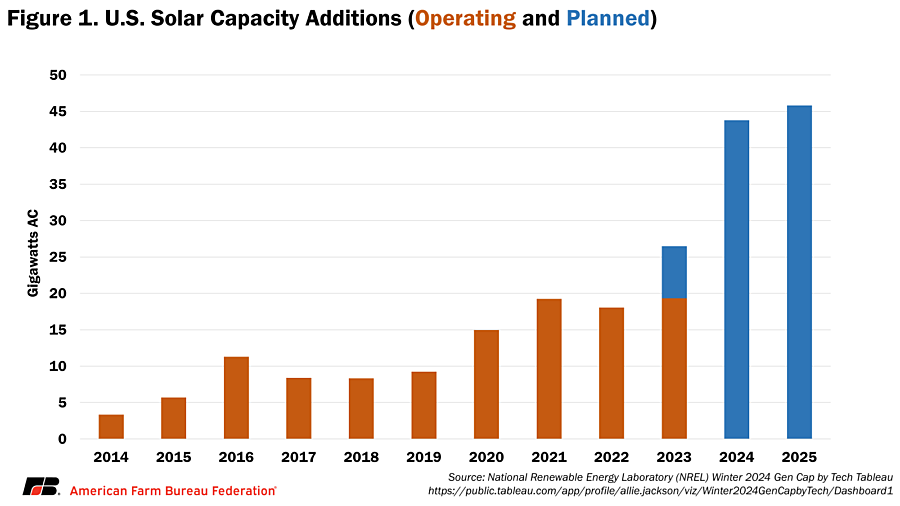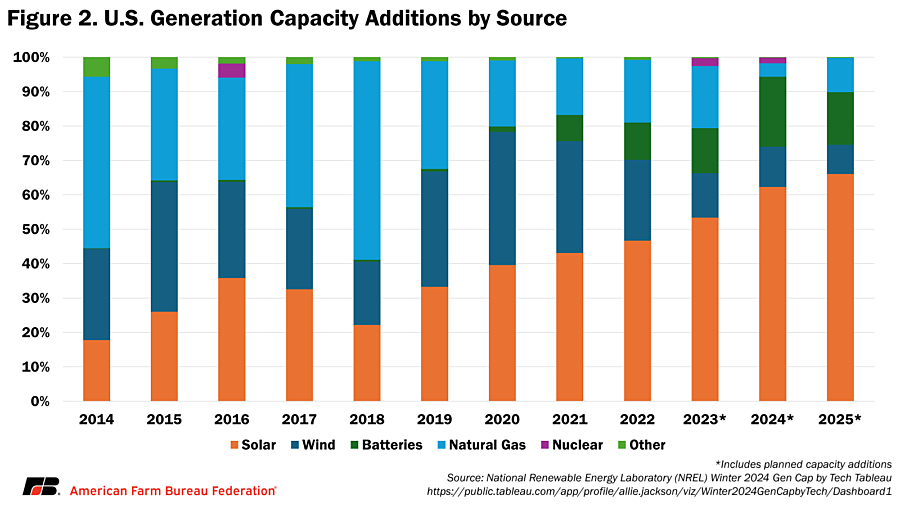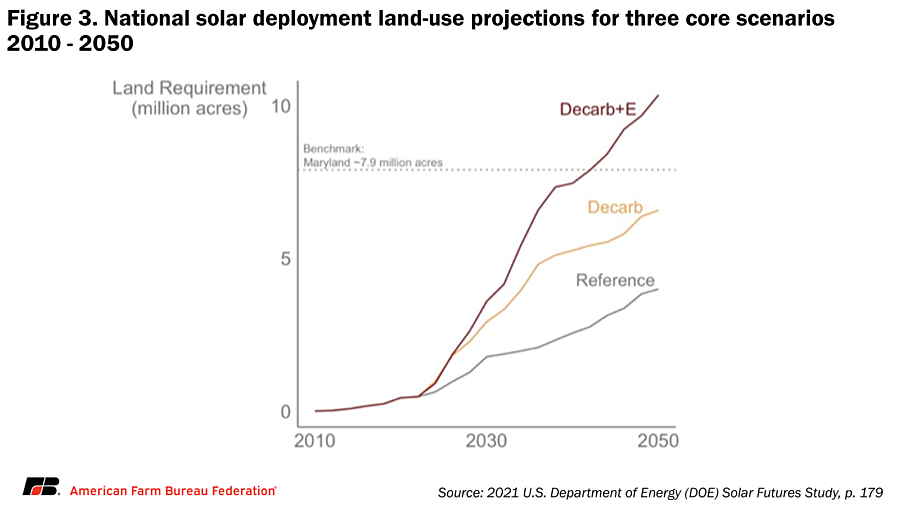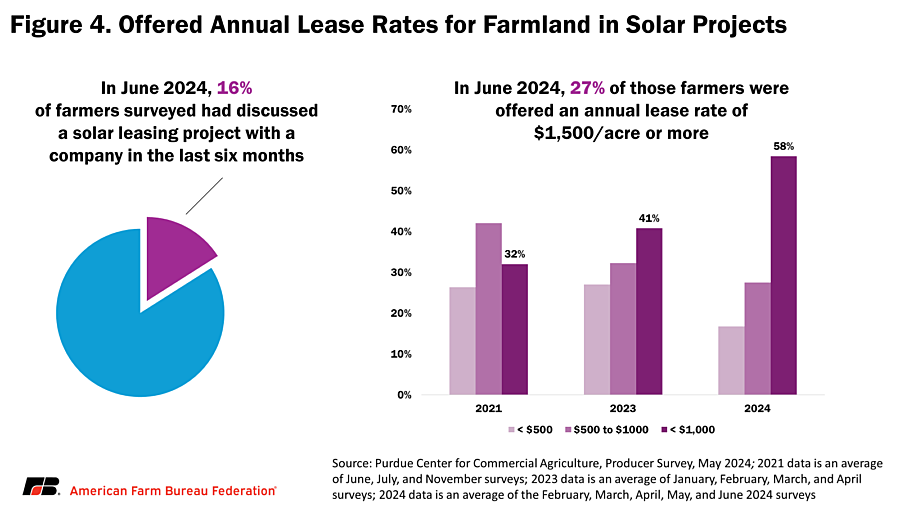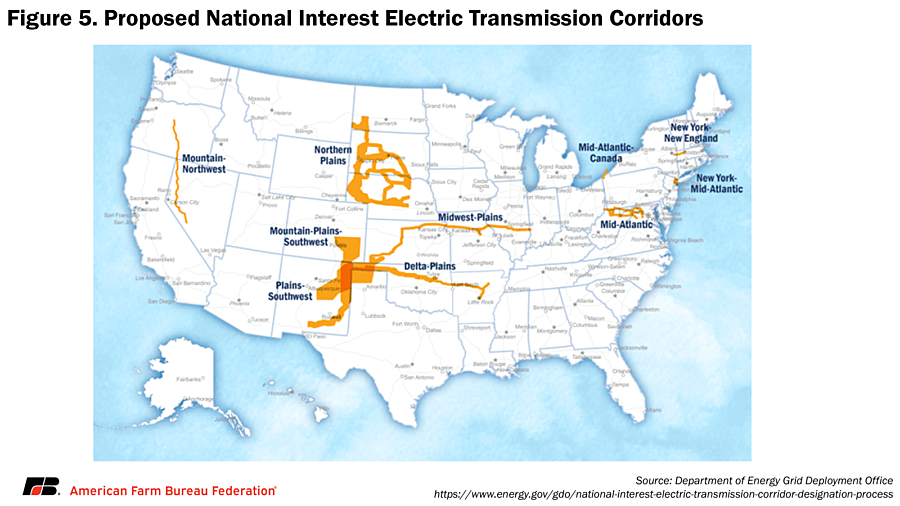Solar Energy Expansion and its Impacts on Rural Communities
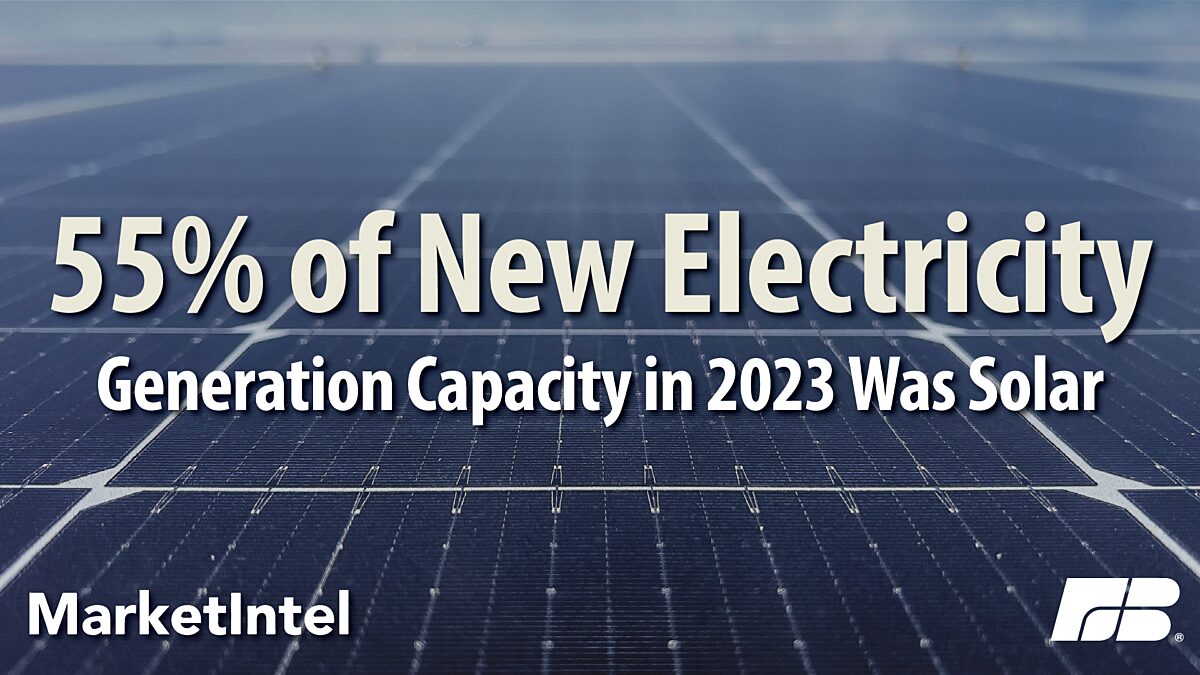
Betty Resnick
Former AFBF Economist
Arica Hamilton
Public Policy Analyst
Alternative energy sources such as wind, geothermal, hydro and solar have grown increasingly popular as ways to reduce greenhouse gas emissions and strengthen the grid by decentralizing power production. Solar energy, which converts energy from the sun into thermal or electrical power, is rapidly expanding across America and the world.
Solar energy can provide numerous benefits but, like most things, also has its share of drawbacks. This Market Intel will dive deeper into solar energy’s expansion and economic impacts, particularly in rural America, where there is great tension between private property rights and concerns over the loss of productive farmland.
Solar’s Growth
Over the last decade, solar energy production has grown 25% on average per year and installation costs have dropped more than 40%, according to the Solar Energy Industries Association (SEIA), which tracks trends and trajectories in the solar industry. Figure 1 shows the dramatic increase in annual solar capacity additions since 2014.
SEIA reports that as of June 2024, 200 gigawatts (GW) of solar energy have been installed across the U.S., generating enough power for 36 million homes. In addition, solar’s share of new grid capacity has grown rapidly, making up 55% of all new electricity generation capacity in 2023 and 75% of new capacity in the first quarter of 2024. This rapid expansion of the solar industry has been financially aided by federal policies and incentives like the Infrastructure Investment and Jobs Act, the Inflation Reduction Act and solar investment tax credits; and also driven by declining solar installation costs.
Research from a 2021 U.S. Department of Energy (DOE) study projects solar energy to rise from 4% of our nation’s total energy production to 45% by 2050, potentially requiring nearly 10.4 million acres of land in solar production. This is about 30% larger than the state of Maryland. DOE expects 90% of projected solar development to be from utility-scale projects in rural communities. Figure 3 is a table pulled directly from the DOE Solar Futures Study.
Solar on Farmland
Although solar development will be distributed nationwide, large utility-scale projects will be concentrated in areas with favorable siting and interconnection opportunities. The ideal location for installing a solar power facility is on land that is clear, dry, relatively flat and close to existing grid infrastructure. Farmland typically meets many of these standards and has lower construction costs compared to other types of land. The same traits that make specific plots of land good for farming can also make them a prime candidate for utility-scale solar.
Modeling by the American Farmland Trust (AFT) finds that 83% of projected solar development will be on agricultural land, of which 49% will be on land AFT deems “nationally significant” due to high levels of productivity, versatility, and resiliency. In May 2024, the U.S. Department of Agriculture’s (USDA) Economic Research Service (ERS) reported that between 2009 and 2020, 43% of solar installations were on land previously used for crop production and 21% on land used as pasture or rangeland. While percentages of projections are readily available, up-to-date national data on the number of acres covered in solar panels is scarce.
The ERS approximates solar’s footprint as of 2020 at 336,000 acres of rural land based on the total solar production capacity installed in U.S. Census designated rural areas. As solar capacity has more than doubled since 2020 and is increasingly coming from utility-scale solar, this estimate is woefully out-of-date. Using SIEA’s current estimate of 200 GW of installed solar capacity, ERS’s estimate of 7.5 acres used per MW of production, and AFT’s estimate that 83% of solar installations are on farmland, we roughly estimate that 1.25 million acres of farmland have been converted for use in solar production. While that may be a startlingly high number to some, it would represent 0.14% of the 879 million acres of farmland in the United States.
Impact on land values
Solar developers can offer significantly higher payments than landowners might earn from renting to other farmers, with many guaranteeing long-term leases lasting 30-35 years. In June 2024, the Purdue Ag Economy Barometer, a monthly survey of farmers and ranchers from across the country, found that 16% of farmers surveyed had discussed a solar leasing project with a company in the last six months. This is an increase from just 12% in March, but a decline from a high of 20% in May. Of the 16% of farmers surveyed in June, 69% were offered an annual lease rate of over $1,000 per acre or more, with 27% offered leases of over $1,500 an acre. Combining results from the April and May surveys, the Ag Economy Barometer also found that 30% of farmers who had been contacted by a solar leasing project had advanced to the contracting stage of negotiations. To compare, the nationwide average cash rental ratefor non-irrigated cropland is $146. In the Midwest, the most expensive non-irrigated cropland to rent is in Iowa at an average rental rate of $276 per acre.
Another consideration is the transitioning of agricultural land used for energy crop production into solar energy. Last year, U.S. farmers planted 94.6 million acres of corn to produce 15.3 billion bushels of corn, of which, 36% was used in ethanol production. Soybeans are also increasingly being used for biofuels, and in the 2024/25 marketing year 14 billion pounds, or 50%, of soy oil used in the U.S. is expected to go to biofuels such as renewable diesel, a 100% renewable alternative to petroleum-based diesel. Renewable diesel and, one day, sustainable aviation fuel are two fuels created from agricultural products that are used to power heavy machinery and airplanes, which will be difficult or impossible to electrify.
While solar energy leasing can help farmers who own land diversify their income, it can be a double-edged sword for farm operators, as more than half of cropland is rented. As solar development in rural areas grows, it drives up demand for land. And as demand goes up, so do land values and rental prices – representing another increasing input cost for farmers.
A recent Reuters analysis found that 12% of USDA-classified prime farmland in Pulaski County, Indiana was under contract to be converted to solar projects. In 2023, the average cash rent for non-irrigated cropland in Pulaski County was $229 an acre, a 26% increase since 2020. Land rents in Pulaski Co. are increasing at a rate significantly higher than the state and national levels for non-irrigated cropland, which increased by 16% and 13%, respectively, over the same period. Pulaski County is a rural area; it is not included in a metropolitan or micropolitan statistical area. It ranks 89 out of 92 Indiana counties in population density at only 28.5 residents per square mile. The increase in land values is seemingly due to the proliferation of solar installations and not urban encroachment.
The rural community angle
The potential for increased land competition and the higher rental rates that come with it aren’t the only cause for unease. Concerns over “nonmonetary impacts” of solar energy leases, including land use changes from agricultural to industrial use, arose in 82% of delayed or stopped utility-scale renewable energy projects between 2008 and 2021, according to an analysis from the Massachusetts Institute of Technology.
The construction of solar facilities on any land area requires clearing and grading, which can result in soil compaction, potential changes in drainage channels and increased runoff and erosion. Additionally, bare and disturbed soil is a favorable environment for noxious and invasive species. Without proper vegetation plans, the function of a solar facility and surrounding agricultural land could be significantly impacted. Some states and localities are making efforts to protect the land under solar facilities. For example, Illinois has instituted agricultural impact mitigation agreements that are required by law to ensure that the land utilized by renewable energy projects is restored to its preconstruction agricultural capabilities after decommissioning.
Quality farmland is clearly not the only place that solar facilities can be built, though it may often be the easiest and least costly place. Private property rights advocates lean heavily toward allowing landowners to use their land for whatever the market will pay for, however, there are robust policy discussions as to on what government assistance for renewable energy should look like. Some hold the belief that incentives should be targeted to avoid or reduce the disruption of productive agriculture. Others question if the federal government should be limiting the landowner’s economic opportunity and decision-making abilities.
Disposal of Decommissioned Panels
Forecasts suggest that 8 million metric tons of solar panels will have reached the end of their lifecycles by 2030. The National Renewable Energy Laboratory reports that less than 10% of decommissioned panels are recycled. Many end up in landfills at the end of their lifecycle, which could be problematic, according to researchers with the Electric Power Research Institute because panels could break and leak toxic materials like lead and cadmium into the soil. If decommissioned panels are not disposed of properly, they could contaminate the surface and groundwater in the surrounding area, making disposal a major issue for farmers and rural communities who rely on groundwater for needs ranging from crop irrigation to drinking water.
Making the Connection
The U.S. electric power grid uses transmission lines to move power from where it is generated to where it is used and is divided into three major regions: the Eastern Interconnection, the Western Interconnection and the ERCOT (Texas) Interconnection. These three interconnections are minimally linked and are not able to share electricity between regions at scale. Managing the transmission planning and electricity distribution within these regions are 10 different regional transmission organizations (RTOs) and independent system operators (ISOs).
One foreseeable challenge with integrating renewables like solar into rural communities is the interconnection queue, or the list of energy projects requesting and awaiting connection to the power grid. According to the Southwest Power Pool (SPP), building a new transmission line can take anywhere from three to nine years. This long process includes a planning study, selection of the transmission owner, design, right-of-way acquisition and construction. As of March 2024, SPP has 31,726 MW of solar energy in generator interconnection requests under study.
Long interconnection queues can cause delays and jeopardize clean energy timelines, creating uncertainties for communities and farmers leasing their land to solar projects. In some instances, the long wait for interconnection has led to land options expiring and the cancellation of entire projects.
An additional concern with the expansion of solar production into rural areas is the transmission infrastructure that must be built and upgraded to support renewable energy. The existing infrastructure was originally designed to meet a very different supply and demand. Solar and wind energy are intermittent, which can cause reliability issues within the current system designed to produce energy consistently. Additionally, as our technology advances to incorporate things like artificial intelligence data centers, the quantity of energy needed will significantly increase to ensure efficient and effective use. Thus, the need for new and upgraded transmission is critical.
However, to farmers and ranchers, the construction of a new transmission line can cause disruptions to agricultural operations, preventing them from efficiently planting, raising and harvesting crops. For example, on May 8, 2024, the DOE proposed a list of 10 potential National Interest Electric Transmission Corridors (NIETCs), areas of the country where DOE has deemed consumers are harmed by the “lack of adequate transmission” and the development of new transmission would advance “important national interests.” If implemented, the NIETCs would impact 21 states through easing acquisition of private property through eminent domain for new transmission line projects.
Advancing an Agriculture-Friendly Solar Industry
While there are several concerning issues related to the integration of solar and agriculture, there are some encouraging developments that may provide a pathway to sustainability for both industries. Agrivoltaics is the co-location of agricultural production and solar energy generation on the same land. At the moment, these projects often consist of sheep grazing, but research is being done to incorporate cattle grazing and crop production. Recently, the Ohio Power Siting Board approved the largest agrivoltaic project in the U.S. This project will be 6,050 acres, have at least 1,000 sheep and produce 2,000 acres of crops in the first year of operation. Within eight years, about 4,000 acres at the Ohio site will be required to include agrivoltaics. While the Ohio project is promising, there are still considerable technical challenges to incorporating productive agriculture at a viable scale into solar systems.
According to the National Renewable Energy Laboratory’s agrivoltaics map, 59% of the nation’s 567 projects defined as incorporating “agrivoltaics” did not list an agricultural output as an outcome, instead exclusively incorporating pollinator or native grass habitats. A new term, ecovoltaics, better suits solar projects incorporating pollinator habitats and is defined as a combined system of energy production and ecosystem services.
Conclusion
The U.S. energy system is undergoing rapid development with exploding electricity demand and power generation shifting toward low-carbon, renewable sources. Solar energy is leading the way, with much of the new development occurring on farmland and in rural communities. It has the potential to be a financial opportunity for landowners, yet it can also create barriers for farmer renters and the next generation. Solar energy can be a great tool in the reduction of greenhouse gases, but it risks decommissioning our most productive agricultural lands. As we navigate towards clean energy solutions, it is critical that we prioritize the preservation of agricultural land. America needs renewable energy sources, and it also needs resilient farms and ranches to continue providing the food, fiber and fuel we all depend on. Ultimately, the issue is not whether we have solar energy production, but where and how we have solar energy production.
Top Issues
VIEW ALL